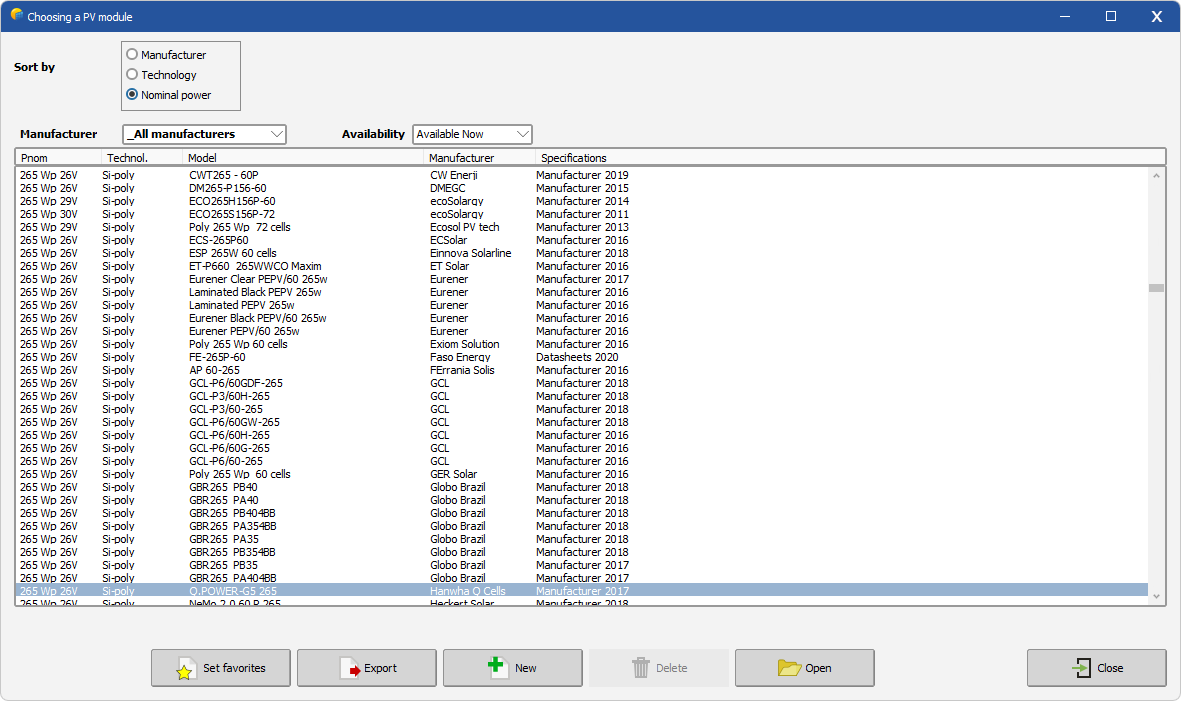Modules in the Database
The PV module database includes about 12'500 devices.
Up to 2008, it was mainly updated using the PHOTON magazine survey, published as printed tables every year.
Since this time, the data are provided by the manufacturers themselves, which improves the reliability. The manufacturers are requested to provide their specifications on a predefined EXCEL document, which is directly included (with careful checks) in the database. These new data are then available with each new issue of the software (i.e. about once a month). There is no on-line update.
This PVsyst database has been limited to modules of power greater than about 35 Wp for Si-crystalline modules, best suited for grid-connected systems.
You have also the opportunity of importing data from the PHOTON database.
When a device is not in the database, you can always define it using the manufacturer's datasheets. You can create it from scratch (New), but the easiest way is to choose an equivalent device, change its characteristics according to the datasheets, and then save it under a different file name, therefore creating a new device in the database.
Warning: PVsyst cannot guarantee the parameters of the database. These may suffer of erroneous transcription (even by manufacturers! ), or modifications in the datasheets. This is the reason why the Data Source parameter usually mentions the year of the latest update. Therefore when effectively using a component, you are strongly advised to carefully check the parameters with respect to your recent datasheets.
PVsyst SA drops out any responsibility about the integrity and the exactness of the data and performances included in the library.
When possible, the data mention the Year of introduction on the market (if not known, this may be the year of introduction in the database). Obsolete devices are marked by the year of retrieval, so that PVsyst has an option for presenting only the available devices in the lists. This cannot of course be quite reliable, as the manufacturers don't use to notice Pvsyst when retrieving a model !
NB: We never suppress old devices from the database, as they may be used by old projects.
The database is stored:
- as a permanent file, renewed with each re-installation of the software.
- as *.PAN files when you create new or modified module by yourself. These are stored in your own working space, and may be exchanged with partners using the tool "Files" / "Import or Export Components" in the main menu.
Uncertain model parameters
Some parameters required by the model are usually not specified in the datasheets nor by usual standards.
These are especially the Rseries and Rshunt values, as well as the Rshunt exponential behavior. PVsyst has to do hypothesis for their determination (on the basis of our own experimental research1 about the model).
Especially the Rserie value has a significant effect on the low-light performance.
The Rserie default value of PVsyst is based on an hypothesis on the Gamma value. In version 5, this lead to very underestimated low-light performances. With the version 6, we have corrected this hypothesis for better approaching the real behavior of modern modules.
However manufacturers sometimes propose Rseries values which enhance the low-light response of their products. When entering these modules in the database, we use to check these parameters, and don't accept values over the standard of Pvsyst unless they provide low-light performances measured by an independent certification institut.
For amorphous modules the additional di²MuTau parameter (completely specific to the PVsyst model), should be determined by the program or by ourselves. Most of the Manufacturer's propositions are not suitable.
-
A. Mermoud
Conception et Dimensionnement de Systèmes Photovoltaïques: Introduction des modules PV en couche minces dans le logiciel PVsyst.
University of Geneva, Projet SIG-NER, Rapport Final (Mai 2005) ↩
